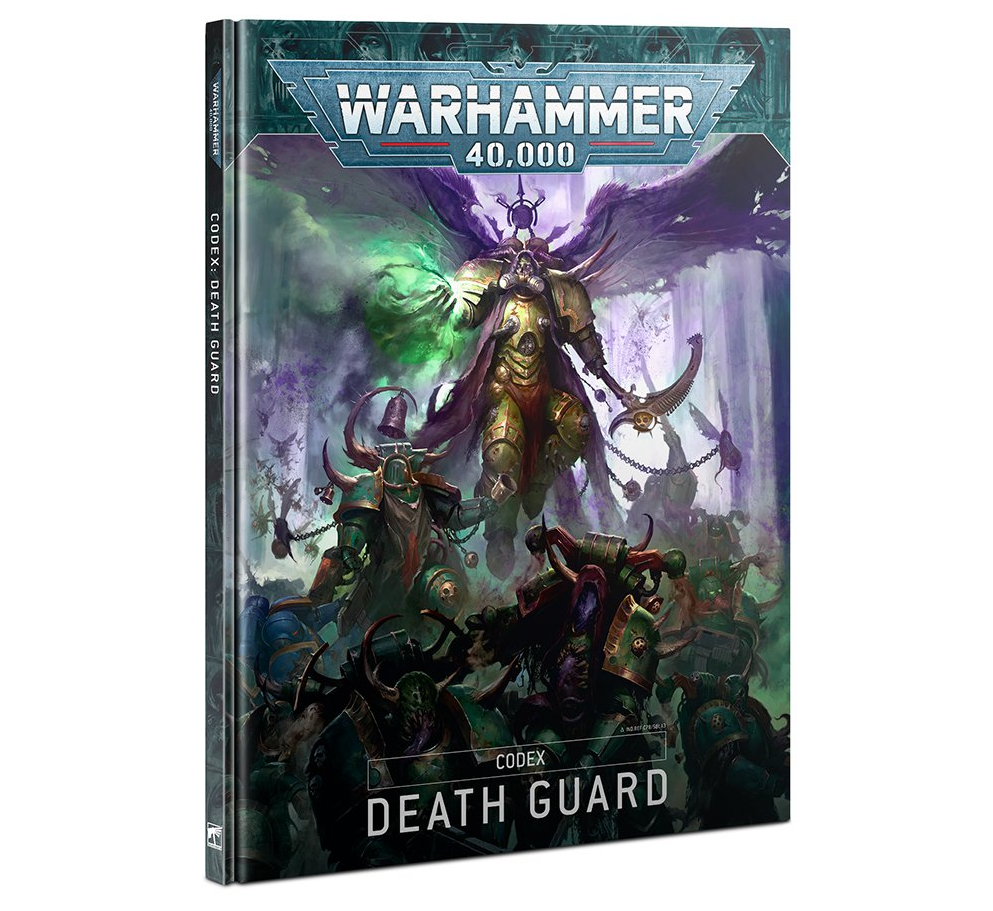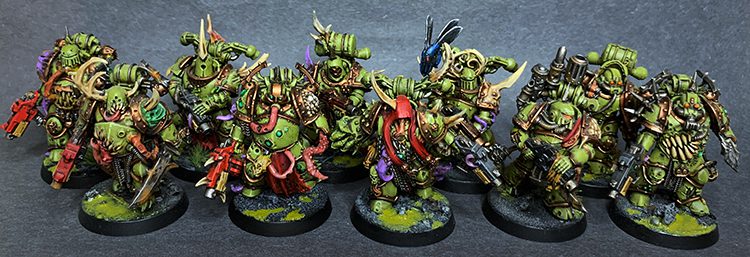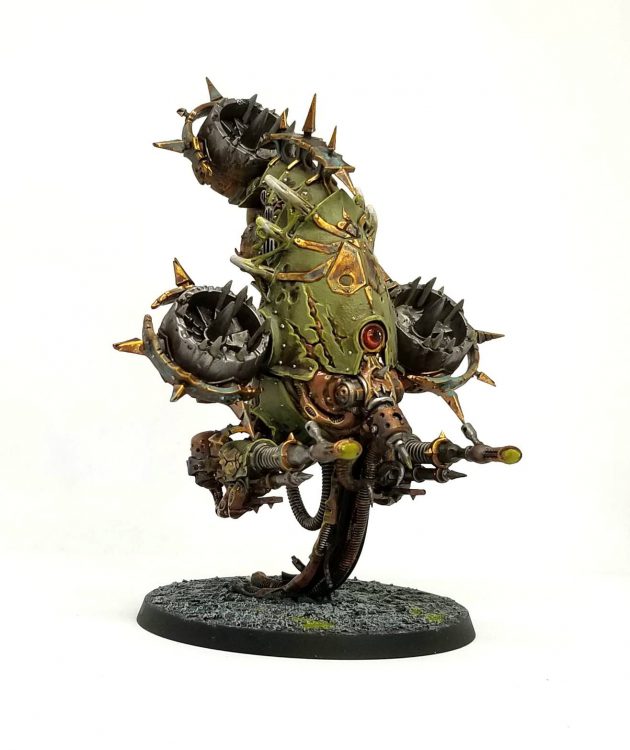Another Codex, another set of Crusade rules. The Death Guard come with similar fare to the other factions we’ve seen released so far, with a slew of agendas, some upgrades for various units, and their own unique campaign mechanic in their Spreaders of Disease rules. But how do they stand up to the other rules released to date? Read on to find out.
Agendas
The first thing you’ll notice with the various agendas is that all of them except one give you Virulence Points, a new resource unique to them. We’ll get to how you’ll spend them later in this review, but you’ll want a steady income of them, especially in the early stages of your campaign as you’re trying to get your army’s unique plague to where you want it.
The first agenda, Honour the Patron, sees your units trying to meet Nurgle’s sacred tally of 7 kills over the course of the battle. Each unit in your army tracks the number of models (not units) they destroyed, and if they get above 7 they gain an XP. As a bonus, if 7 or more units from your army each got at least 3 kills, you’ll gain a Virulence point. This is a fairly easy way to pick up some XP for one or two of your more dangerous units, and the Virulence point isn’t that hard to get. Turn Their Hope to Rot sees you gunning for your opponent’s highest-PL unit, and giving the lucky unit that gets the killing blow 3XP, plus 1 Virulence for your army. Poison the Well introduces an additional action for non-character infantry in your list that they can take to contaminate a piece of area terrain they’re standing in. Each time a unit successfully completes the action, they gain 2XP, and the bonus Virulence point will be yours if you can contaminate at least half the area terrain on the board.
The other two agendas here are split – the first, Sow the Infection, Harvest the Plague, doesn’t offer experience, but could potentially give you 2 Virulence points. It’s not too difficult to score, either – you get a point for each objective within range of any of your army’s contagions at the end of the battle round, and you only need to pick up 7 to get at least 1 Virulence. The other agenda, Gene-Seed Thief, is the Space Marines’ Recover Gene-Seed through the looking glass. You’ll place a fallen Space Marine hero on the ground, then use your Plague Surgeon to take an action to steal the progenoids from the corpse, gaining 5xp and a Requisition point for your trouble. If you want to get a quick rank onto a fresh Plague Surgeon, look no further.
Beanith: I love these Agendas, they are incredibly thematic. The one I’d probably use most often would be Sow the Infection, Harvest the Plague to easily gain those tasty Virulence Points. Just being in Contagion range of objectives, especially in the later stages of the game, shouldn’t be too difficult.
Condit: I think my favorite is Poison the Well – more interaction with terrain is always a good thing. It also creates the most tension on the Virulence point reward, as you’ll eventually have to move into contested ground in order to get above 50% contamination.
TheChirurgeon: I actually kind of love Gene-Seed Thief. It’s exactly the kind of faction-specific rule I think belongs in Crusade and I love how it plays into the fluff for how traitor legions maintain their numbers. Also the reward for it is pretty hefty. The only thing that’s weird to me is that you can take this against non-marines. I’d have almost preferred something that turned down marine characters into objective markers. But it’s still pretty neat.
Spreaders of Disease
This is the real meat of the Death Guard’s Crusade rules, and will see you generating a unique plague from 216 different combinations for your Warlord to spread as the Plague Carrier. Later as the campaign progresses, you will be able to spend Requisition and Virulence points to upgrade upto three other Death Guard characters to also become Plague Carriers .
To start, you’ll roll on three tables, determining your plague’s Vector, Infection, and Terminus; or, in other words, how your plague infects units, what it does once it gets them, and how you’ll determine when it ends.
Vectors include Weeping, which will contaminate a unit hit with a ranged attack at half range on a 4+, Seeping, which contaminates enemies within 3” of any Plague Carrier at the end of your Command phase on a 2+, and Festering, which lets your Plague Carriers take an Action to automatically infect every enemy within 6”. Once they’re contaminated, they suffer the plague’s effect until its Terminus is triggered. These include Growths, which cause it to end on a 2+ if they take any casualties, Cysts, which lets a unit take an action to remove the contamination, or Ulcers, which sees you rolling for each contaminated unit, clearing the infection on a 4-6, but spreading it further on a 1-3.
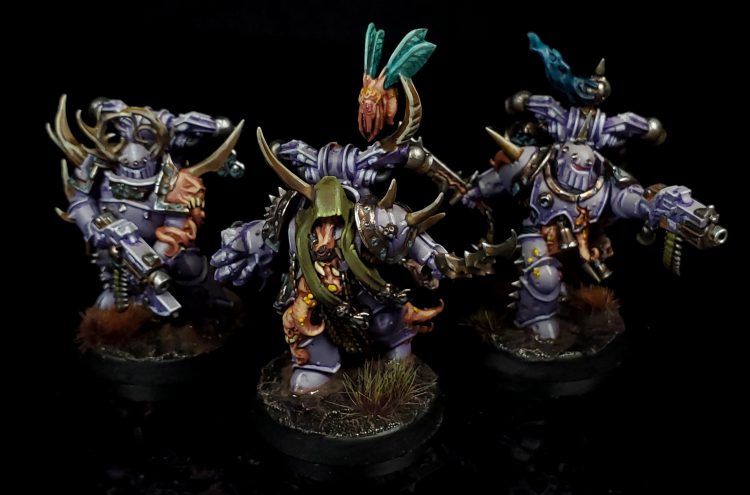
The Infection effects are honestly pretty cool, too. Pox-ridden halves advance and charge rolls, letting you further control where your enemy goes and dictating the pace of the battle. Ravaging deals d3 mortal wounds on first infection, then deals an additional mortal wound at the start of each of your Command phases. Infectious, one of the more interesting ones, stops enemies from performing actions on a 4+, potentially preventing them from meeting mission objectives and making many agendas that much harder to score. Each of the effects has its uses, and different players may gravitate toward different ones. I’m excited to see how these different options play out once they make it to the table.
Condit: If there’s one thing I thought I wouldn’t like when I first saw it, it was giving Death Guard yet another plague for me to have to play around, but these seem interesting. Locking it to specific characters and putting it on a timer of sorts is an interesting way of making sure it won’t just completely ruin your opponent’s day when combined with Gift of Nurgle and whatever other ridiculous contagion your Warlord is packing. Plus, adding some more stuff for your characters to do is always cool.
Beanith: Just for a giggle I rolled to see what my Lord of Contagion has and Grandfather Nurgle has a sense of humor when I rolled Weeping Pitted Sores… maybe if I throw my Manreaper at the enemy, would that count as a ranged attack? I think my first battle will be to gain some Virulence Points to perhaps change the Vector to something usable for Stinky Steeve. That said, you will be changing and updating your Plague as the campaign goes on and you add more Plague Carriers to your roster.
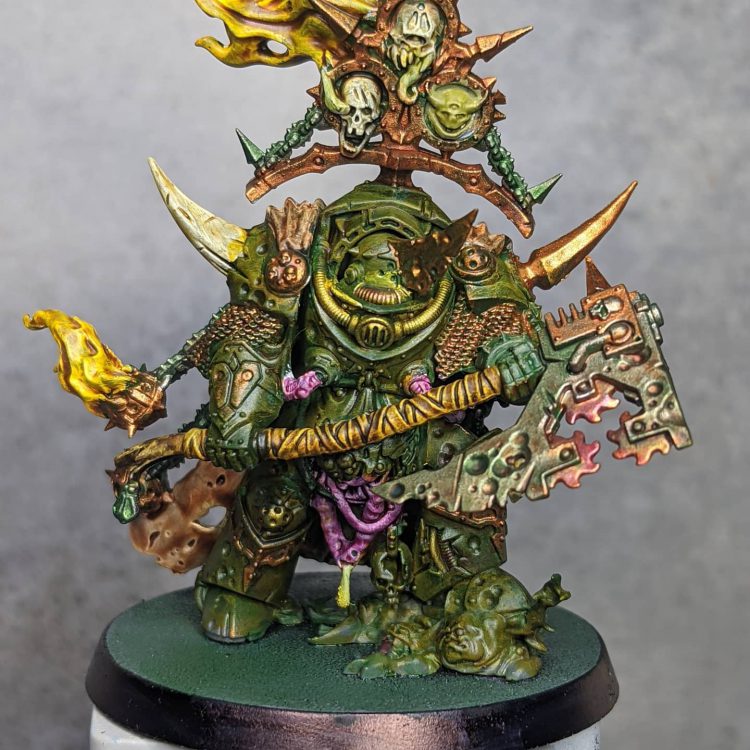
I feel GW missed an opportunity here to involve any of the Foetid Virion such as the Biologus Putrifier or Tallyman when it comes to tinkering with the Plague. That minor gripe aside, there is an easily obtained Crusade Relic mentioned later which will help here.
TheChirurgeon: I love these – they’re basically what everyone asking for custom plague companies was looking for, since the primary thing that sets plague companies apart is their special Warlord Trait plague.
Battle Traits
The Death Guard also bring three tables of Battle Traits that your units will be able to choose from as they gain experience. The first two are pretty standard fare, with one for infantry and one for daemon engines. Your choices here are pretty cool, and have thematic names that evoke the ongoing corruption of your Death Guard army – Tri-lobes on infantry units will add 1 to hit rolls with ranged attacks, while a squad that’s been mutated to have Writing Tentacles can ignore penalties to hit rolls with melee attacks. Daemon engines can be covered in Infectious Buboes which can explode and deal mortal wounds to enemies in engagement range, or they can sprout Spider Limbs that let them move horizontally (though not vertically) through models and terrain features.
Those tables are fine, but the really cool one is the Chaos Boons table. When a non-Daemonic Bubonic Astartes Character unit would gain a Battle Honour, you can instead roll on this table. You roll two d3s in sequence to generate a two digit number, then compare to the nine options on the table. The effects here are pretty straightforward, with most offering simple, if useful, characteristic increases. You can only ever get 3 of these.

Accepting Grandfather’s blessings is risky, though: when you roll on the table, if the result is one that character already has, the mutations run rampant and he’s reduced to a gibbering mass of diseased flesh. You’ll remove the character from your roster, and add a lone Chaos Spawn.
Beanith: I like the Infantry and Vehicle upgrade tables, they all seem usable and present a great excuse to convert your models to show their cool new upgrades. I’d recommend getting your hands on a Chaos Spawn sprue, it has heaps of tentacles, bones and spikes. Also one of the Goonhammer maxims is Always Be Overcharging, I feel that we can add Always Be Booning to the Goonhammer Chaos list of maxims. I mean, what are the chances you’ll roll the same mutation twice?
TheChirurgeon: Sounds like a good future Hammer of Math article to me.
Requisitions
Virulent Adaptations is how you’ll spend those Virulence Points you’re collecting with your agendas, and will let you re-roll one of the three aspects of your unique plague, letting you eventually settle on a bespoke disease that you can be proud to offer to all of your friends. Once you’ve finished your research and development process, Plague-Marked will help you spread the love by giving a character in your list the PLAGUE CARRIER keyword.
The other two have to do with the Death Guard version of Even in Death I Still Serve. While being interred in a Dreadnought sarcophagus is a tremendous honor for any loyal Son of the Primarchs, even the most corrupted Heretic Astartes know better than to ask to be shoved into a Helbrute. After all, why do that when you could chase Daemonhood? When a Death Guard unit with 3 Chaos Boons would gain a Battle Honour or another Chaos Boon, you can instead spend 1RP to have them apotheosize into a Daemon Prince, keeping their experience and gaining the appropriate number of Battle Honours. And while getting 4 advances might seem far off, you can speed up the process with Path to Glory, which grants your Warlord a Chaos Boon if he killed the enemy Warlord in a game you won.

TheChirurgeon: I like Daemonhood because it’s much more straightforward than the long, silly process of dying so many times you get shoved into a dreadnought, and keys off my character getting better over time.
Condit: I also like Daemonhood, because there’s like a 30% chance your character “gets better” by devolving into a Chaos spawn across 3 rolls on the Boon table.
Beanith: Pffft to Daemonhood I say, who wouldn’t rather have Heroic/Legendary level Chaos Spawn running around instead?

Crusade Relics
In addition to the other options, your Death Guard characters will also get four Crusade Relics to choose from. The Billowing Censer adds 2 to rolls to see if friendly models within 9” explode on death, while the Corrupted Emblem lets you add or subtract 1 to your roll with the Virulent Adaptations requisition if the bearer was in your list for your most recent game. Their Antiquity Relic, the Orb of Decay, lets the bearer unleash a wave of hateful diseases, rolling a d6 for each enemy unit within 6” and doing more mortal wounds the higher they roll. Finally, the Warp Charm of Nurgle, thankfully only available to Legendary-ranked characters, gives the character of your choice the equivalent of Mortarion’s Toxic Presence ability, letting them always use the Contagion range for rounds 4+, even from the start of the game.
TheChirurgeon: The Billowing Censer is hilarious when you consider that most Death Guard vehicles explode on a 4+ and the explosions don’t hurt your dudes.
Beanith: Everyone and their Dog/Nurgling will have a cheap Death Guard Character with the Corrupted Emblem relic whose only job is to show up for a battle for the bonus to the Virulent Adaptations requisition. At least try and be thematic and make it a Biologus Putrifier. Also do take the Billowing Censer as well for the exact same reason as TheChirurgeon stated.
Wrap-up
All in all, GW’s most recent entry in its Crusade rules is more of what you were expecting: a set of useful and flavorful upgrades for your force combined with a core mechanic that really leans into the theme of the army. Whether you’re running a list full of melee-focused tentacle-sprouting plague marines, or a set of myphytic blight haulers on spider legs who jump right over your opponent’s screen to unload into their vulnerable targets, you’ve got plenty of opportunities to build your narrative, and even more fuel for conversions and kitbashes, if you’re into that.
Condit: I don’t think this is my favorite of the Crusade rules so far (that honor probably still remains with the Necrons’ Dynastic Epithets table), but it’s a solid addition that I can’t wait to see on the table.
Beanith: I think it’s pretty cool and will probably end up being my second Crusade army once I tire of get tabled with my Necron Crusade army. I’m also keen to see what fun things the Death Guard get in the next Crusade book: Plague Purge Mission Pack.
Have any questions or feedback? Drop us a note in the comments below or email us at contact@goonhammer.com.
